CRAZY FOR GEOLOGY - WHAT ARE THE SEISMIC WAVES - Part I
Greetings friends ...
Today I want to start with a series called Locos por la Geologia, this series of published articles will be related to the study of the physical properties that are present in our land as well as establishing some particular characteristics of concepts that define science of Geology, in this first installment we will be talking about the seismic waves, if those waves that move in undulated form and that are constantly presented in earthquakes, product of the tectonic movements that occur in the earth's crust, in that article you can know "What are the seismic waves, types of seismic waves, characteristic elements of seismic waves, as well as other key concepts that define this type of physical event that occurs in our land, if I talk more I want you to go into this "MAD WORLD FOR GEOLOGY", if you liked this content, I invite you to comment and vote.
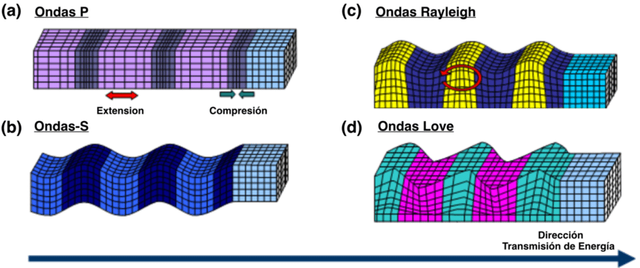
Image source:researchgate.net
CRAZY FOR GEOLOGY -Part I
What are Seismic Waves?
Seismic waves are a type of strong elastic wave in the propagation of temporary disturbances of the stress field that generate small movements in the tectonic plates.
Seismic waves can be generated by natural earthquakes, the largest of which can cause damage in areas where there are urban settlements. There is a whole branch of seismology, which is responsible for the study of this type of physical phenomena. Seismic waves can also be generated artificially, such as the use of explosives or trucks (vibroseis). Seismic is the branch of seismology that studies these artificial waves.
Types of seismic waves
There are two types of seismic waves: internal (or body) waves and surface waves. There are other modes of wave propagation, but they are of relatively minor importance for the waves produced on Earth, although they are important in the field of asteroseismology, especially in helioseismology.
Waves (P and S) (R and L)
The application of a punctual effort by the instantaneous release of energy in a rock mass produces a deformation proportional to that effort, governed by Hooke's Law for relatively small efforts that do not exceed the elastic limit of the medium.
From the moment when the balance between stress and deformation breaks, for example when the applied effort ceases, the deformation propagates through the rocky medium like an elastic wave. There are several types of waves that are generated and propagated from that moment.
For prospective purposes, they can be classified into two groups:
Volumetric waves that are transmitted through the material may undergo refraction and reflection processes. They are the waves of understanding (P) and those of shear (S).
Superficial waves, Rayleigh and Love types that are transmitted through the surface with minimal penetration in the material. The study of these waves in prospective terms has less interest than that of the volumetric waves although there are specific methods based on their study as the Spectral Analysis of Surface Waves.
From the interior point of the earth where an earthquake occurs, various elastic waves are produced that propagate in all directions. These waves are detected by seismographs, instruments of continuous recording and that consist simply of a pendulum to which diverse mechanisms of amplification, of damping, of registration are attached. etc. A detailed study of the seismic signals inscribed in the seismograms, as they are called to the records of the seismographs, allows us to know the main characteristics of the tremor that produced them. Since the movement produced by a tremor has three components (one vertical and two horizontal) to register each of the components.
The study of a large number of seismograms has made it possible to differentiate two main types of seismic waves: body waves and surface waves.The body waves are the fastest, and therefore they are the first recorded by the seismographs. These waves are divided into longitudinal or compressional (P waves) and transverse or cut (S waves).
Body Waves (Volumetric)
Waves P
They are the first to reach the seismographs therefore the fastest.
- They depend on the compressibility of the medium (such as sound): compression waves. They are transmitted by successive compressions and decompressions of the medium, with volume changes.
- As solids, liquids and gases can be compressed, they are propagated by all means.
- The movement of vibration of the particles is parallel to the direction of propagation, which implies greater speed.
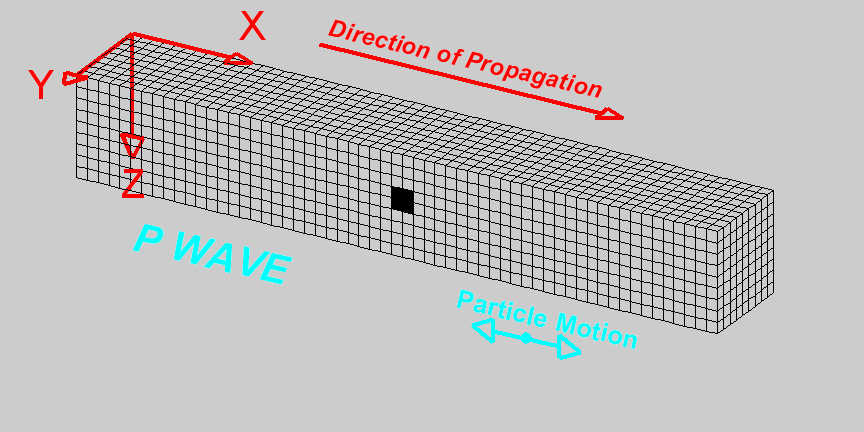
S waves
They are the second to reach the seismographs, therefore less fast than the P.
- Depend on the elasticity (stiffness) of the rocks: shear waves. They are transmitted by a shearing deformation (↓) that does not vary the volume.
- As solids have elastic properties and liquids and gases do not, they only propagate in solid medium.
- The movement of vibration of the particles is perpendicular to the direction of propagation, which implies a greater travel (slower speed).

Surface waves
Surface waves represent the energy that has been trapped on the earth's surface and are generated by the constructive interaction of body waves with the internal structure of the earth. This type of waves propagate parallel to the free surface of medium. In shallow earthquakes are those that carry more energy those with greater destructive effect.
Another characteristic of this type of waves is that they have a maximum amplitude in the free surface and decreases exponentially with depth. They can be recorded at great distances, because at differences in body waves, they suffer a goometric dispersion with distance that is much smaller (~ 1 / √R for surface waves, while for body waves it is ~ 1 / R).
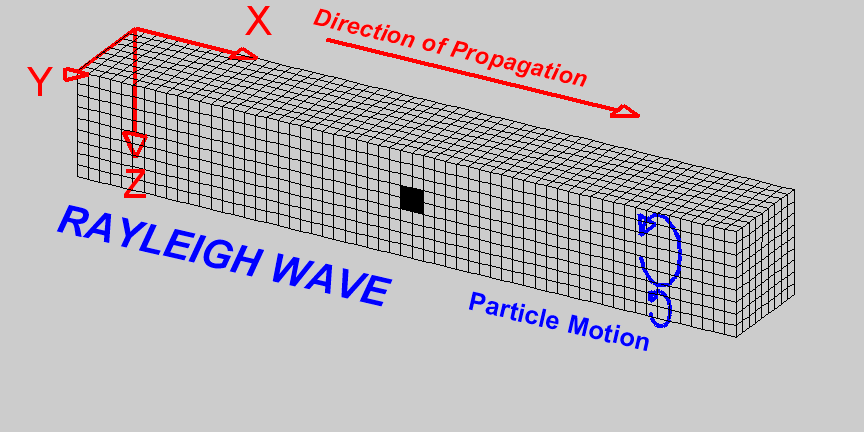
Although surface waves arrive after body waves, in some cases they are almost entirely responsible for the damage and destruction of associated earthquakes. This damage and the strength of surface waves are reduced in deeper earthquakes. Another important property of surface waves is that they exhibit dispersion, which is because the speed of the wave on the surface depends on its frequency (or period).
As mentioned above, one type of surface waves are Rayleigh waves, named after Johb William Strutt (known as Lord Rayleigh), who mathematically predicted the existence of this kind of waves in 1885. These are long period waves that they produce an elliptical-longitudinal movement of the particles on a vertical plane.
There are basically two types of surface waves: Rayleigh waves and Love waves. These waves play a very important role in seismology, not only because they are the most prominent amplitude waves in a seismogram recorded at a great distance, but also because they can be used in estimates of the seismic moment, the focal mechanism, the focal depth of remote earthquakes and in the discrimination between tremors and nuclear tests.
They are the result of the interaction on the surface of the incidence of P waves and flat SV waves and travel parallel to the surface. Rayleigh waves travel along the surface with a particle movement that retrograde elliptical, that is, the particles of the material move by describing an ellipse in the opposite direction to the direction of propagation of energy. Said movement changes to progrado with the depth passing through a node in which there is no particle movement. The vertical axis of the ellipse is always the one with the greatest amplitude.
The propagation speed of Rayleigh waves Vr is smaller than S waves, this Vr = 0.92 Vs (for a Poisson ratio v = 1/4). However, this propagation speed varies depending on the period of the wave, which is why Rayleigh waves are said to be dispersive waves, meaning that the different harmonic components of the Rayleigh waves constituting an earthquake travel with different speeds.
Another type of surface waves are Love waves. These are formed by the constructive interference of multiple reflections on the free surface of SH waves. Love waves are faster than Rayleigh waves and therefore arrive before her on the seismogram. The particle movement for the Love wave is parallel to the surface but perpendicular to the direction of propagation and is found in the horizontal component of the seismogram. Love waves are also dispersive, that is, the speed of propagation of the wave depends on its frequency, being higher for lower frequencies.
Waves L
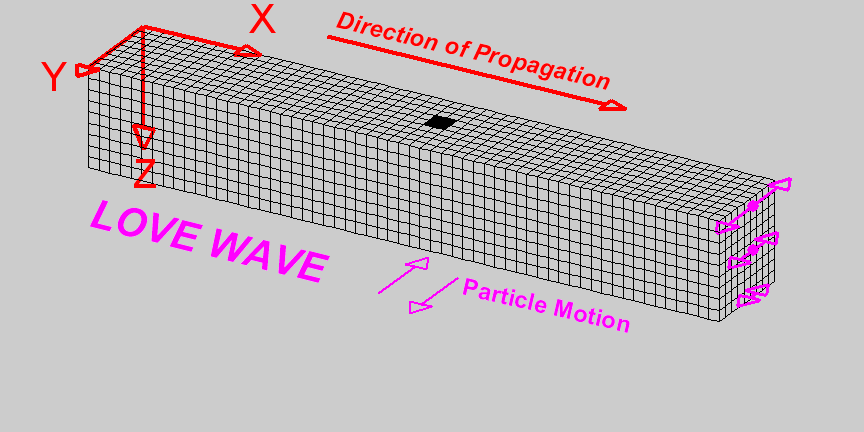
What elements characterize seismic waves?
Actually these terms that we will see below do not apply only to this kind of waves, but to all those that represent a sinusoidal movement, and we will use them, for example, also for the marine waves.
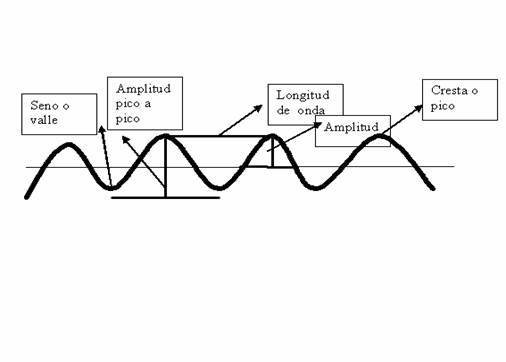
In the drawing, the line that crosses the waves is what is considered as the central axis, up and down from which the particles will move in the transverse waves and along which they will move in the longitudinal waves, as we will see later.
Crest or peak is the point of maximum displacement above that central axis.
Sine or valley is the point of maximum displacement below that central axis.
Wavelength (lambda λ) is the horizontal distance between two sines or two consecutive crests.
Wave amplitude is the vertical distance from the central axis to the sine or to the crest.
Amplitude from peak to peak is the vertical distance between the sine and the crest. It corresponds to double the amplitude.
It should be clarified that there is a certain disagreement between the various authors regarding these last two terms, since some call wave amplitude to what we call here peak-to-peak amplitude, and use the term semiamplitude for half of it, ie what in the graph we call amplitude.
They are simple semantic disagreements, nothing serious, you choose the definition that you like the most.
Finally we must define frequency and period, two concepts perfectly inverse to each other.
Period is the time it takes for two successive crests (or two breasts) to pass through a certain place.
Frequency is the amount of ridges (or sinuses) that pass through a given place in the unit of time.
There are two concepts related to speed, the greater this is, the less time is required for two successive steps of crests or breasts for a place, and more times they pass in each unit of time. P = 1 / F, that is: Period = 1 / Frequency and vice versa.
Usefulness of seismic waves
Seismic waves are used in oil exploration and are generated in different ways:
- Minisismos generated by dynamite placed in a well created that can vary only a few tens of meters deep.
- Minisismos generated with an explosive cable called geoflex.
- Minisismos generated by vehicles called vibrators, these are vehicles of several tons of weight that have a platform of about 3 by 4 meters of area, and with an electronic, electrical and mechanical-hydraulic system.
They can also be used to study the different materials inside the earth, (whether liquid, or solid, even the dull layers) thanks to the variations in the speed of the P depending on the stiffness or when passing through liquid media, and the loss of the S when coming into contact with liquid media (shirred stones, etc).
Bibliography :
- Biot, M. A. (1962). «Mechanics of Deformation and Acoustic Propagation in Porous Media». Journal of Applied Physics 33 (4).
- Alex H. Barbat (ed.). ¨Monographs of Seismic Engineering .. International Center for Numerical Methods in Engineering, Andalusian Institute of Geophysics and Prevention of Seismic Disasters.
You received a 10.0% upvote since you are not yet a member of geopolis and wrote in the category of "geology".
To read more about us and what we do, click here.
https://steemit.com/geopolis/@geopolis/geopolis-the-community-for-global-sciences-update-4